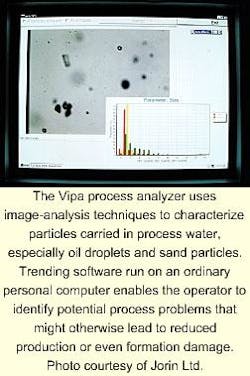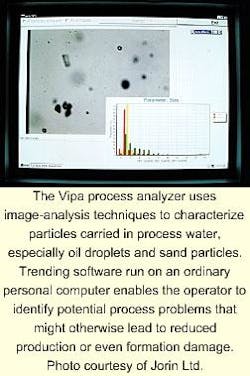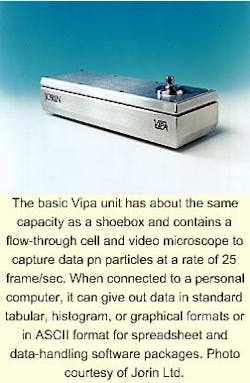Jorin's Particle Analyzer Designed To Improve Oil/Water Separation
Produced water is a headache for offshore operators, but a British company has designed an instrument intended to make analysis and decision-making easier.
Jorin Ltd., Sandhurst, U.K., developed the instrument after identifying the operators' problems in handling oil and solids in water, but the instrument is expected to prove useful in other petroleum industry applications.
Rick Gaskin, sales and marketing director, and Director John Roth were working together 5 years ago for a small company importing scientific instruments.
Roth had an idea for a particle-size analyzer that he thought would be of great use to North Sea oil and gas producers. As a result, Jorin was incorporated in July 1998 to produce the Vipa visual process analyzer.
Tightening environmental regulations are increasingly curbing the disposal of untreated produced water in the sea, and offshore operators are turning more and more to water reinjection to boost production rates as fields mature.
Jorin discovered that the viability of reinjection of produced water depends on a number of factors, including the size and concentration of both oil and solid particles in the water. If particles of the wrong size are reinjected in sufficient quantities, production rates can decline sharply.
"We came to the conclusion," said Gaskin, "that there was a ready market for an instrument that would measure the size of oil droplets and solid particles in process output water."
What Vipa does
Vipa captures images of particles in process water, and a proprietary software package "puts distinct numbers on what it finds." Gaskin explained that the application required an instrument capable of measuring a number of parameters of each particle examined.
It is housed in a box 430 mm long by 130 mm wide and 120 m deep and weighs 6 kg. It contains a flow-through cell and a video microscope, which records snapshots of the process stream for image analysis and can be used to display the data on a screen.
The instrument measures 14 parameters per particle, including the aspect ratio, which is the relationship between the longest and the shortest distances across the perimeter and the area. The measurements enable particle types, such as oil droplets or sand grains, to be characterized by one or more of these parameters. For example, oil droplets in water are most easily identified by their shape, which is almost spherical, while sand particles are jagged crystals.
The data are viewed as an overall distribution for all particles present, or, for example, just the oil or sand. Once the distinction between oil and sand and other matter has been made, properties such as size distribution and relative concentration can be monitored for each type of particle present. The Vipa, which is linked to a standard personal computer, can track up to eight particle types simultaneously.
"With these parameters we can categorize by type of particulate material," said Gaskin. "All these data are recorded along with a particle number and time, so that an individual particle or event can be traced."
By taking samples regularly-the acquisition rate is 25 frames/sec of data-and adding the data to a trend database, the instrument can help predict trends in the process stream.
"It is more important to know what a process will do than what it has done," said Gaskin. "The Vipa can be set up to monitor the size and relative concentration of oil droplets and solid particles in produced water prior to reinjection.
"The alarm function can be set to give advanced warning that the size or concentrations are tending towards levels that could cause injectivity problems in the near future. This enables preemptive action to be taken, whereas now operators only know they have a problem when they begin to lose injectivity because of formation damage."


